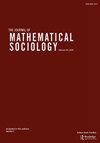The life cycle model of chinese empire dynamics (221 BC–1912 AD)
IF 0.7
4区 社会学
Q3 MATHEMATICS, INTERDISCIPLINARY APPLICATIONS
引用次数: 2
Abstract
ABSTRACT The life cycle pattern is pervasive for both natural and social sciences, from human behaviors to social systems. Based on the life cycle model of collective actions, the man–land relationship governs the rise and fall cycles, namely dynastic cycles. We combine agent-based modeling, systemic dynamics, and numerical simulations, to build the life cycle model of empires. It aims to investigate the rise and fall process of 18 major dynasties (empires) in history of China, from BC 221 to AD 1912. The core aim is to find optimal solutions, which achieve the best matching between simulations and real history. According to our algorithm, the optimal solutions can be obtained, when we have the minimal span differences (gaps) between simulated and real empires. First, we traverse all related parameters, and select simulations with 18 empires. Second, we select the cases with the total ticks between 2122 and 2132 years (ticks). Third, we select cases whose differences (gaps) are within 20 years. Finally, we obtain three optimal solutions (combinations of parameters) whose validity (100 simulations) and robustness (1000 simulations) have been checked. It seems that our life cycle model has achieved the best fitness to real empires in the history of China. For distributive matching of durations (spans), both discrete and continuous forms can be matched. Besides, the simulate and real durations can be matched as well, under counterfactual inferences of 16–17, 18 & 19–20 pairs. Based on our model, the whole history process of China can be back-calculated. Therefore, it seems that the trend of human history (society) may be an automatic process, which cannot be altered by man’s will.中国帝国动态的生命周期模型(公元前221年-公元1912年)
生命周期模式在自然科学和社会科学中无处不在,从人类行为到社会系统。基于集体行动的生命周期模型,人地关系支配着兴衰周期,即王朝周期。我们将基于主体的建模、系统动力学和数值模拟结合起来,构建帝国的生命周期模型。它旨在研究中国历史上18个主要王朝(帝国)的兴衰过程,从公元前221年到公元1912年。其核心目标是寻找最优解,使仿真与真实历史达到最佳匹配。根据我们的算法,当模拟帝国与真实帝国之间的跨度差异(差距)最小时,可以得到最优解。首先,我们遍历所有相关参数,并选择18个帝国的模拟。其次,选取总蜱数在2122 ~ 2132年(蜱数)之间的病例。第三,我们选择差异(差距)在20年以内的案例。最后,我们得到了三个最优解(参数组合),其有效性(100次模拟)和鲁棒性(1000次模拟)已被检查。看来我们的生命周期模式在中国历史上最适合真正的帝国。对于持续时间(跨度)的分布匹配,离散形式和连续形式都可以匹配。此外,在16 - 17,18和19-20对反事实推理下,模拟和真实的持续时间也可以匹配。基于该模型,可以回溯中国的整个历史进程。因此,人类历史(社会)的趋势似乎是一个自动的过程,不能被人的意志所改变。
本文章由计算机程序翻译,如有差异,请以英文原文为准。
求助全文
约1分钟内获得全文
求助全文
来源期刊

Journal of Mathematical Sociology
数学-数学跨学科应用
CiteScore
2.90
自引率
10.00%
发文量
5
审稿时长
>12 weeks
期刊介绍:
The goal of the Journal of Mathematical Sociology is to publish models and mathematical techniques that would likely be useful to professional sociologists. The Journal also welcomes papers of mutual interest to social scientists and other social and behavioral scientists, as well as papers by non-social scientists that may encourage fruitful connections between sociology and other disciplines. Reviews of new or developing areas of mathematics and mathematical modeling that may have significant applications in sociology will also be considered.
The Journal of Mathematical Sociology is published in association with the International Network for Social Network Analysis, the Japanese Association for Mathematical Sociology, the Mathematical Sociology Section of the American Sociological Association, and the Methodology Section of the American Sociological Association.
 求助内容:
求助内容: 应助结果提醒方式:
应助结果提醒方式:


